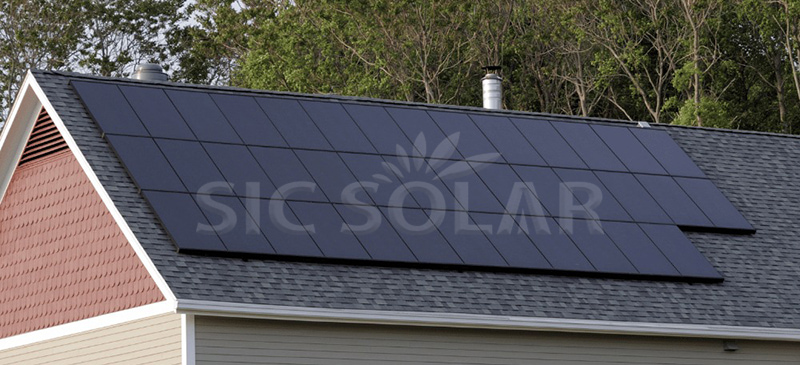Installing solar panels is a smart investment for reducing energy costs and embracing renewable energy. But if you’re considering a solar installation, one of the key factors to think about is your roof type. Not all roofs are equally suited for solar panels, and choosing the right setup is crucial for both efficiency and longevity of your solar system.

Factors That Make a Roof Ideal for Solar Panels
Before diving into specific roof types, it’s essential to understand the characteristics that make a roof ideal for solar panels:
- Roof Orientation:
For maximum efficiency, solar panels should be installed on a roof that faces south in the northern hemisphere, or north in the southern hemisphere. This allows the panels to capture the most sunlight throughout the day. East- and west-facing roofs can also work, but with slightly reduced efficiency. - Roof Pitch:
The ideal roof slope for solar panels is between 30 and 45 degrees. This angle allows the panels to capture sunlight more effectively throughout the day. However, even flat roofs can accommodate solar panels with the help of angled mounting brackets. - Structural Integrity:
Solar panels add extra weight to your roof, so it’s important that your roof is structurally sound. Before installation, ensure your roof can support the additional weight of the solar panels and mounting system. This is where quality mounting systems like those provided by SIC Solar become essential, as they ensure the panels are securely and safely attached to your roof. - Material Compatibility:
Some roofing materials are more compatible with solar panels than others. The ease of installation, durability, and how the panels are mounted can vary significantly depending on your roof material.
Best Roof Types for Solar Panels
- Asphalt Shingle Roofs
Why They’re Good for Solar Panels:
Asphalt shingle roofs are the most common roofing type in many countries, and they’re also among the easiest to install solar panels on. Their uniform, flat surface makes it easy to attach the necessary mounting hardware without compromising the integrity of the roof.Considerations:
Since asphalt shingles have a lifespan of around 20 to 30 years, it’s important to ensure your roof is in good condition before installing solar panels. If your roof needs to be replaced soon, it’s better to do so before your solar installation. - Metal Roofs
Why They’re Good for Solar Panels:
Metal roofs are highly durable and can last over 50 years, making them an excellent long-term investment for solar panel installations. The standing seams on metal roofs allow for easy mounting without the need for drilling, minimizing the risk of leaks.Considerations:
Standing seam metal roofs are ideal for solar panel installations because of their pre-existing seams, which allow installers to use special clamps for attaching the panels. Corrugated metal roofs can also work, but they may require more specialized mounting systems. - Tile Roofs (Clay, Concrete, Slate)
Why They’re Good for Solar Panels:
Tile roofs, whether made of clay, concrete, or slate, are known for their durability and long lifespan. Solar panels can be installed on tile roofs with specialized mounting systems that lift the tiles to avoid damaging them.Considerations:
Tile roofs require careful installation due to their fragility. Specialized mounting systems from companies like SIC Solar are crucial to ensure that the tiles are not broken during the installation process. These roofs also tend to be more labor-intensive to work with, which may increase installation time and cost. - Flat Roofs
Why They’re Good for Solar Panels:
Flat roofs offer flexibility when it comes to solar panel placement. Since flat roofs don’t have a natural slope, installers can use adjustable mounting systems to tilt the panels to the optimal angle for sun exposure.Considerations:
With flat roofs, it’s essential to use high-quality brackets or tilt racks to ensure the solar panels are positioned at the best angle. Flat roofs also need careful consideration regarding drainage to prevent water pooling around the solar mounting hardware. - Wood Shake Roofs
Why They’re Less Common for Solar Panels:
Wood shake roofs, while aesthetically pleasing, are less common for solar installations due to their fragility and potential fire risk. Installing solar panels on wood shake roofs may require specialized mounting systems to avoid damage to the wooden shingles.Considerations:
If you have a wood shake roof and are considering solar panels, it’s important to consult with a professional installer to ensure the integrity of the roof is maintained during installation. Fire safety considerations may also play a role in whether this roof type is suitable for solar panels.
Mounting Systems: A Crucial Part of Solar Installation
Regardless of your roof type, the mounting system plays a critical role in the success of your solar installation. A well-designed and sturdy mounting system ensures that your panels stay securely in place, even in adverse weather conditions. Companies like SIC Solar specialize in producing high-quality photovoltaic mounting systems that cater to various roof types, ensuring your solar panels are installed safely and efficiently.
For example, metal roofs often benefit from clamp-based systems, while asphalt shingle roofs require rails that are securely bolted into the structure of the roof. Proper mounting also ensures that the panels are angled correctly to maximize energy production, especially on flat or low-pitch roofs.